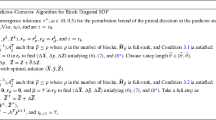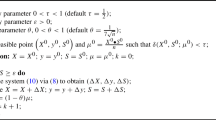Abstract
We present a successive linearization method with a trust region-type globalization for the solution of nonlinear semidefinite programs. At each iteration, the method solves a quadratic semidefinite program, which can be converted to a linear semidefinite program with a second order cone constraint. A subproblem of this kind can be solved quite efficiently by using some recent software for semidefinite and second-order cone programs. The method is shown to be globally convergent under certain assumptions. Numerical results on some nonlinear semidefinite programs including optimization problems with bilinear matrix inequalities are reported to illustrate the behaviour of the proposed method.
Similar content being viewed by others
References
B. Borchers, “SDPLIB 1.2, A library of semidefinite programming test problems,” Optimization Methods and Software, vol. 11, pp. 597–611, 1999.
R. Correa and H. Ramirez, “A global algorithm for nonlinear semidefinite programming,” SIAM Journal on Optimization, vol. 15, pp. 303–318, 2004.
B. Fares, D. Noll, and P. Apkarian, “Robust control via sequential semidefinite programming,” SIAM Journal on Control and Optimization, vol. 40, pp. 1791–1820, 2002.
A. Forsgren, “Optimality conditions for nonconvex semidefinite programming,” Mathematical Programming, vol. 88, pp. 105–128, 2000.
R.W. Freund and F. Jarre, “A sensitivity analysis and a convergence result for a sequential semidefinite programming method,” Technical Report, Bell Laboratories, Murray Hill, New Jersey, 2003.
M. Fukuda and M. Kojima, “Branch-and-cut algorithms for the bilinear matrix inequality eigenvalue problem,” Computational Optimization and Applications, vol. 19, pp. 79–105, 2001.
M. Fukushima, K. Takazawa, S. Ohsaki, and T. Ibaraki, “Successive linearization methods for large-scale nonlinear programming problems,” Japan Journal of Industrial and Applied Mathematics, vol. 9, pp. 117–132, 1992.
K.C. Goh, L. Turan, M.G. Safonov, G.P. Papavassilopoulos, and J.H. Ly, “Biaffine matrix inequality properties and computational methods,” in Proceedings of the American Control Conference, Baltimore, Maryland, June 1994, pp. 850–855.
R.E. Griffith and R.A. Stewart, “A nonlinear programming technique for the optimization of continuous processing systems,” Management Science, vol. 7, pp. 379–392, 1961.
C.W.J. Hol, C.W. Scherer, E.G. van der Meché, and O.H. Bosgra, “A nonlinear SDP approach to fixed-order controller synthesis and comparison with two other methods applied to an active suspension system,” European Journal of Control, vol. 9, pp. 11–26, 2003.
X.X. Huang, K.L. Teo, and X.Q. Yang, “Approximate augmented Lagrangian functions and nonlinear semidefinite programs,” Technical Report, Department of Applied Mathematics, The Hong Kong Polytechnic University, Hong Kong, China, 2003.
F. Jarre, “An interior method for nonconvex semidefinite programs,” Optimization and Engineering, vol. 1, pp. 347–372, 2000.
F. Jarre, “Some aspects of nonlinear semidefinite programs,” in System Modeling and Optimization XX, F.W. Sachs and R. Tichatschke (Eds.), Kluwer Academic Publishers, 2003, pp. 55–69.
M. Kočvara and M. Stingl, “PENNON: A code for convex nonlinear and semidefinite programming,” Optimization Methods and Software, vol. 18, pp. 317–333, 2003.
F. Leibfritz, “An LMI-based algorithm for designing suboptimal static ℍ2/ℍ∞ output feedback controllers,” SIAM Journal on Control and Optimization, vol. 39, pp. 1711–1735, 2001.
Z.-Q. Luo, “Optimal transceiver design via convex programming,” Technical Report, Department of Electrical and Computer Engineering, McMaster University, Hamilton, Canada, 1999.
F. Palacios-Gomez, L. Lasdon, and M. Engquist, “Nonlinear optimization by successive linear programming,” Management Science, vol. 28, pp. 1106–1120, 1982.
A. Shapiro, “First and second order analysis of nonlinear semidefinite programs,” Mathematical Programming, vol. 77, pp. 301–320, 1997.
J.F. Sturm, “Using SeDuMi 1.02, a MATLAB toolbox for optimization over symmetric cones,” Optimization Methods and Software, vols. 11–12, pp. 625–653, 1999.
M.J. Todd, “Semidefinite optimization,” Acta Numerica, vol. 10, pp. 515–560, 2001.
K.C. Toh, R.H. Tütüncü, and M.J. Todd, “SDPT3 version 3.02—a MATLAB software for semidefinite-quadratic-linear programming,” updated in December 2002, http://www.math.nus.edu.sg/mattohkc/sdpt3.html.
R.H. Tütüncü, K.C. Toh, and M.J. Todd, “Solving semidefinite-quadratic-linear programs using SDPT3,” Mathematical Programming, vol. 95, pp. 189–217, 2003.
J. Zhang, N.-H. Kim, and L. Lasdon, “An improved successive linear programming algorithm,” Management Science, vol. 31, pp. 1312–1331, 1985.
Author information
Authors and Affiliations
Corresponding author
Additional information
The research of the fourth author was supported in part by a Grant-in-Aid for Scientific Research from Japan Society for the Promotion of Science. The research of the second author was supported by the DFG (Deutsche Forschungsgemeinschaft).
Rights and permissions
About this article
Cite this article
Kanzow, C., Nagel, C., Kato, H. et al. Successive Linearization Methods for Nonlinear Semidefinite Programs. Comput Optim Applic 31, 251–273 (2005). https://doi.org/10.1007/s10589-005-3231-4
Received:
Revised:
Accepted:
Published:
Issue Date:
DOI: https://doi.org/10.1007/s10589-005-3231-4




